
Teaching the History of Graphic Design course
I retired from classroom teaching in December of 2016. Later, I thought about developing and teaching a class for adults through AIGA, pared down to six weeks, no tests or homework.
In 2019, was asked about teaching an online course at Penn State, but, I realized that would not be a good fit. My expertise blossoms in front of a live audience.
Sunday, September 15, during a television interview with 90 year old Milton Glaser: I realized that it's time to let go of ever teaching design history again, in any form. I am no longer willing to do the amount of work required to keep it updated and fresh. I don’t want to video it, I don’t wanna do it for adults, or in a classroom with today’s students. I did it in a time and place that was just the right recipe for me to succeed. That has all changed - student commitment, supervisor support, and one can now access the information more easily.
I did a remarkable job developing a course when few universities even taught design history. It was interesting, funny, engaging, and inspirational. It was a wonderful experience, a phenomenal course as evidenced by the evaluations and comments I still receive today.
Course stats
• 12 lectures
• 9,914 images (average 800 images/lecture)
• 3-6 tests
• 1 StyleBook semester project
• 1 Final Exam
• 54 total sections of classes
• 2,400+ students
Dates and locations
1984-1987: Brookhaven College, Dallas County Community College District: History & Psychology of Visual Communication, 3 sections
1987-2008: University of Central Oklahoma History & Psychology of Graphic Design, History & Theory of Graphic Design, History of Graphic Design, 28 sections.
2000-2003: University of Oklahoma, History of Visual Communication, 4 sections
2004: Scanned all slides to digital images; Built lectures in Keynote, added text.
1998-2016: Oklahoma State University: History of Graphic Design, 19 sections
The History of Graphic Design course
Graphic Design in social media from Cave marks to Digital web; the History of Graphic Design is an overview of the historical styles, movements, people, and events of design to help inspire one to design more creative, appropriate, and intelligent solutions to advertising and design problems.
Lecture episodes
The lecture have been edited to reduce the number of images and to speed up loading
and scrolling and the lectures have not been updated or had images added since 2016.
Course syllabus

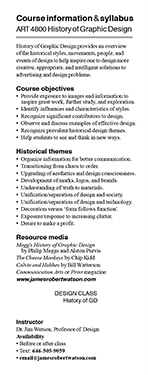
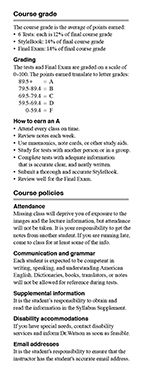
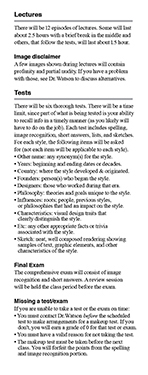
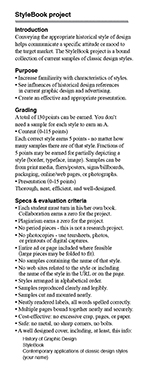


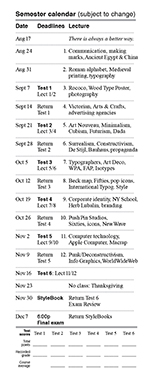
The goal of the course was for the student to be inspired or fascinated by some person, movement, style, technology, company, event, or logo.
• Provide exposure to images and information to inspire great work, further study, and exploration.
• Identify influences and characteristics of design styles.
• Recognize significant contributors to design and pop culture - that were game-changers.
• Observe and discuss examples of effective design.
• Recognize prevalent historical design themes.
• Help students to see and think in new ways and to realize that there's always a better way.
• Organize information for better communication.
• Exposure/response to increasing clutter: transitioning from chaos to order.
• Upgrading of aesthetics and design consciousness.
• Development of marks, logos, and brands.
• Understanding of/truth to materials.
• Unification/separation of design and technology.
• Decoration versus ‘form follows function'.
• Desire to make a profit.
• There's always a better way.
• Meggs' History of Graphic Design by Philip Meggs and Alston Purvis
• The Cheese Monkeys and The Learners by Chip Kidd
• Calvin and Hobbes by Bill Watterson
• Communication Arts magazine
• Disneyland, Walt Disney World, or any Disney park
The course grade is the average of points earned:
• 6 Tests: each is 12% of the final course grade.
• StyleBook: 14% of the final course grade.
• Final Exam: 14% of the final course grade.
The tests and Final Exam are graded on a scale of 0 to 100. Opportunities to earn bonus points are available on each of the 6 tests.
The points earned translate to letter grades:
90 - 100 = A (89.5 +)
80 - 90 = B (79.5 - 89.4)
70 - 80 = C (69.5 - 79.4)
60 - 70 = D (59.5 - 69.4)
0 - 60 = F (0 - 59.4)
• Attend every class on time.
• Review notes each week.
• For test study: use mnemonics, note cards, or other study aids.
• Study for tests with another person or in a group.
• Complete tests with adequate information that is accurate clear, and neatly written. adequate number of accurate styles.
• Submit a thorough and accurate StyleBook.
• Review well for the Final Exam.
Missing class will deprive you of exposure to the images and the lecture, but attendance will not be taken. It is your responsibility to get the notes from another student. If you're running late, come to class for at least some of the info.
Each student is expected to be competent in writing, speaking, and understanding American English. Dictionaries, books, translators, or notes will not be allowed for reference during tests.
If you have special needs, contact disability services and inform Dr. Watson as soon as feasible.
Grad student syllabus
An overview of the historical styles, movements, people, and events of design. Students will take the 6 tests (on a higher grading scale) from the lecture course, but will not do the StyleBook project nor take the Final Exam.
• Add to the body of knowledge in Design History.
• Develop and state topic, conduct research, analyze and assess findings, form conclusions, present orally and in writing.
• Practice composing a quality graduate-level research paper.
• Improve confidence to show initiative and independent thinking,
• Practice correct grammar and clear communication.
The tests are graded on a scale of 0 to 100. The points earned translate to letter grades:
92 - 100 = A (91.5 +)
84 - 91 = B (83.5 - 91.4)
76 - 83 = C (75.5 - 83.4)
68 - 75 = D (67.5 - 75.4)
0 - 67 = F (0 - 67.4)
The research project or paper must be:
• Student initiated.
• Substantial for graduate credit.
• Impactful and appropriate: it must provide substantial value for designers or educators.
• Have a historical application, in any design area.
• Proposal (10% of grade): One page statement of topic and why it’s important to you.
• Abstract (10%): Revised topic, objectives, methodology, process, format.
• Outline (10%)
• Rough draft (20%)
• Final project presentation (50%)
• Concept: topic Impactfulness, validity, appropriateness.
• Communication: Clear problem statement and persuasive conclusion, thorough exploration.
• Execution: Neatness, design and layout format.
• Spelling and grammar
Semester calendar
• Syllabus, 'There's always a better way.'
• Lecture 1: Communication, making marks, Ancient Egypt & China
• Lecture 2: Roman alphabet, Medieval manuscript, printing, typography
• Test 1 over Lectures 1 & 2
• Lecture 3: Rococo, Wood Type Poster, photography
• Return & discuss Test 1
• Lecture 4: Victorian, advertising agencies, Arts & Crafts
• Test 2 over Lectures 3 & 4
• Lecture 5: Art Nouveau, Minimalism, Cubism, Futurism, Dada
• Return & discuss Test 2
• Lecture 6: Surrealism, Constructivism, De Stijl, Bauhaus, Tschichold, propaganda
• Test 3 over Lectures 5 & 6
• Lecture 7: Beck map, Isotypes, Art Deco, WPA
• Return & discuss Test 3
• Lecture 8: The Fifties, pop icons, International Typographic Style
• Test 4 over Lectures 7 & 8
• Lecture 9: Corporate identity, branding, Herb Lubalin
• Return & discuss Test 4
• Lecture 10: Push Pin Studios, Sixties, icons, New Wave
• Test 5 over Lectures 9 & 10
• Lecture 11: Computer technology, Apple Computer, Macrap
• Return & discuss Test 5
• Lecture 12: Punk, Information Graphics, Internet, WorldWideWeb
• Test 6 over Lectures 11 & 12
• No class - Thanksgiving holiday
• StyleBooks due
• Return & discuss Test 6
• Review for Final Exam
• Return StyleBooks
• Final exam
• Grades posted online
Lectures
There will be 12 episodes of lectures. Some will last about 2.5 hours with a brief break in the middle and others, that follow the tests, will last about 1.5 hours. Below are lists of the styles, contributors, and terms included in each lecture, as an overview and to provide correct spelling.
Image disclaimer: A few images shown during lectures will contain profanity and partial nudity. If you have a problem with that, see Dr. Watson to discuss alternatives.
Lecture keywords

Sample Keynote screen images
The screens are laid out in a 'webpage' format - several images or lines of text on a page - what students are used to from media on their computers, tablets, and phones.
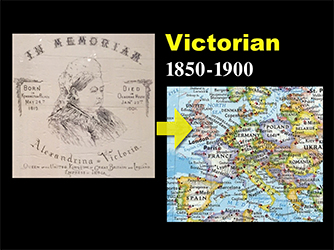

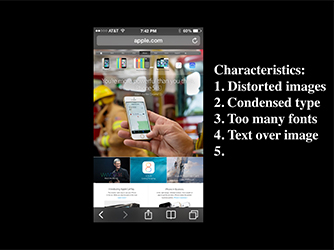

Font sampler project
Typeface designers have been creating new fonts since the beginning of communication. Often, they will develop typefaces that reflect the fashion and trends of the era. Sometimes, fonts are designed to convey a specific earlier style.
Find samples of fonts that are clearly associated with the styles listed below. Scan, capture, or photograph them; print, mount, and bind the pages together. Consider this project as a resource for later reference and inspiration.
• Size: letter
• Paper color: white
• Ink color: black
Each appropriate and clearly labeled font is worth 5 points. The presentation is worth 20 points.
• All specs followed precisely.
• Fonts that clearly convey a specific style.
• Pages bound neatly.
• Pleasing page layout.
• In on time.
• Make decisions on appropriate selection of type.
• Become familiar with a variety of font resources.
• Develop a neat presentation of information.
• Software font menus
• U&lc and type catalogs
• Design books
___ Egyptian
___ Chinese
___ Medieval
___ Rococo
___ Victorian
___ Wood Type Poster
___ Arts & Crafts
___ Art Nouveau
___ Constructivism
___ De Stijl
___ Bauhaus
___ Art Deco
___ Fifties
___ ITS
___ Lubalin
___ Sixties
___ New Wave
___ Punk
___ Millennium
___ Ornament
___ Web, digital
___ __________________
___ __________________
StyleBook project
Contemporary applications of classic design styles.
Conveying the appropriate historical style of design helps communicate a specific attitude or mood to the target market. The StyleBook project is a bound collection of current samples of classic design styles.

• Increase familiarity with characteristics of styles.
• See influences of historical design references in current graphic design and advertising.
• Create an effective and appropriate presentation.
A total of 130 points can be earned. You don't need a sample for each style to earn an A.
Content (0-115 points)
Each correct style earns 5 points - no matter how many samples there are of that style. Fractions of 5 points may be earned for partially depicting a style (border, typeface, or some other element). Samples can be from print media, fliers/posters, signs/billboards, packaging, online/web pages, or photographs.
Presentation (0-15 points)
Thorough, neat, efficient, and well-designed.
• Each student must turn in his/her own book. Collaboration earns a zero for the project.
• Plagiarism earns a zero for the project.
• No period pieces - this is not a research project.
• No photocopies - use tearsheets, photos, or printouts of digital captures.
• Entire ad or page included where feasible (large pieces may be folded to fit.)
• No samples containing the name of that style.
• No web sites related to the style or including the name of the style in the URL or on the page.
• Styles arranged in alphabetical order.
• Organized for easy access.
• Samples reproduced clearly and legibly.
• Samples cut and mounted neatly.
• Neatly rendered labels.
• All words spelled correctly.
• Multiple pages bound together neatly and securely.
• Cost-effective: no excessive crap, pages, or paper.
• Safe: no metal, no sharp corners, no bolts.
• A well designed cover, including, at least, this info:
History of Graphic Design
StyleBook
Contemporary applications of classic design styles
(your name)
• Art Deco, Art Moderne
• Art Nouveau
• Arts & Crafts, Mission, Craftsman
• Beck map (not a transit map)
• Constructivism
• Cubism
• De Stijl, Mondrian
• Fifties, Doo Wop
• Futurism
• Information Graphics (not USA Today)
• International Typographic Style
• Lubalin type treatment
• Macrap
• Medieval, Illuminated Manuscript
• Minimalism
• New Wave, Post Modern
• Propaganda poster
• Punk, Deconstructivism
• Rococo
• Sixties
• Surrealism
• Victorian
• Wood Type Poster
• Other
Tests
Typically, art history evaluation is to write about a designer/artist, movement, or style. Or compare and contrast 2 or 3 styles. But, then the student learns about a few styles, not the whole gamut overview of design history. I would love (like most teachers) to not have to do any grading. But, student evaluation and assessment is necessary:
1. Need an efficient way to communicate to other instructors, grad school applications, GPA.
2. Motivation for students to review materials and remember and retain more info.
3. I structured the tests to be a learning tool, providing new info or a different way of seeing previous info.
The comprehensive exam will consist of image recognition and short answer questions. A review session will be held the class period before the exam.
If you are unable to take a test or the exam on time:
• You must contact Dr.Watson before the scheduled test to make arrangements for a makeup test. If you don't, you will earn a grade of 0 for that test or exam.
• You must have a valid reason for not taking the test.
• The makeup test must be taken before the next class.
There will be six thorough tests. There will be a time limit, since part of what is being tested is your ability to recall info in a timely manner (as you likely will have to do on the job). Each test includes spelling, style recognition, definitions, contributors, short answers, lists, design styles, and style sketches. For each style, the following items will be asked for (not each item will be applicable to each style).
• Other name: any synonym(s) for the style.
• Years: beginning and ending dates or decades.
• Country: where the style developed & originated.
• Founders: person(s) who began the style.
• Designers: those who worked during that era and are associated with the style.
• Philosophy: theories and goals unique to the style.
• Influences: roots; people, previous styles, or philosophies that had an impact on the style.
• Characteristics: visual design traits that clearly distinguish the style.
• Etc: any other appropriate facts or trivia associated with the style.
• Sketch: neat, well composed rendering showing samples of text, graphic elements, and other characteristics of the style.
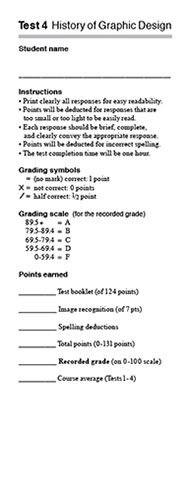
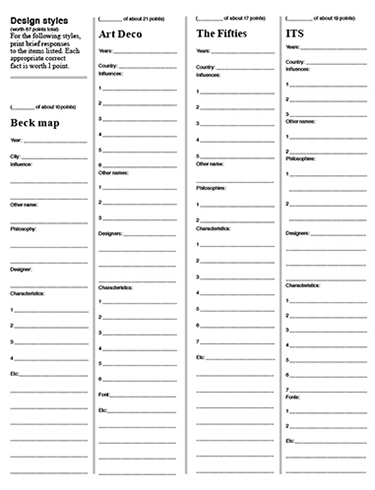
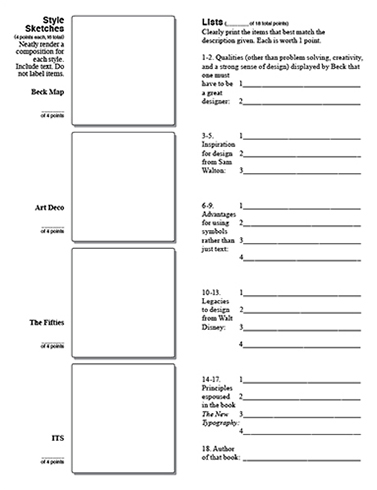
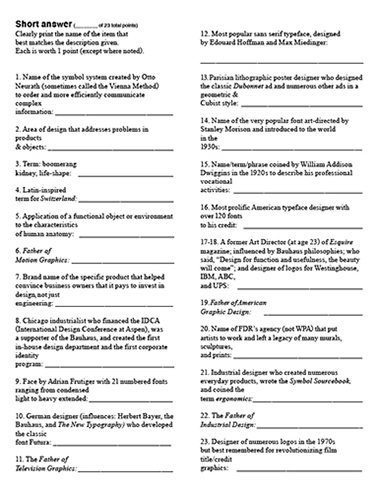

The comprehensive exam consisted of image recognition and short answer questions. The exam: keywords given, fill in the word that best fits - one page, with all answers on one side.


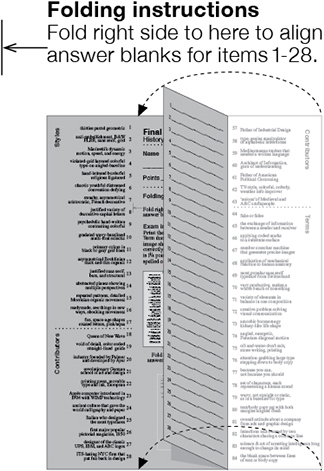
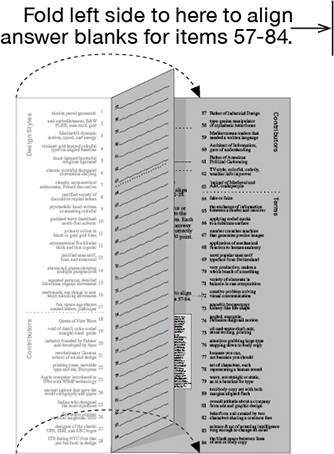
Slides to introduce and explain the exam:
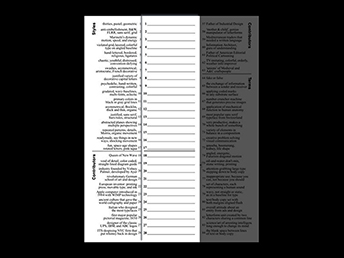
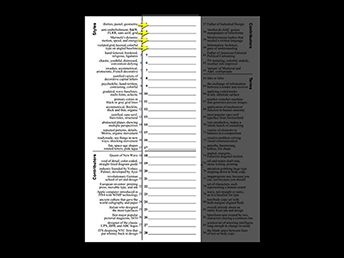
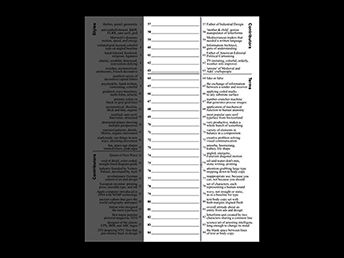
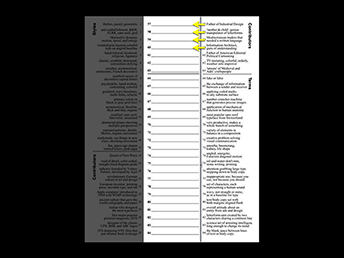
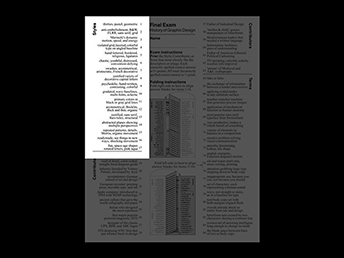
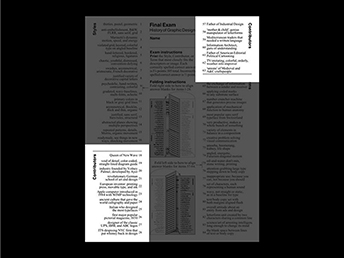




Style samples
A resource guide for test sketches and the StyleBook
First section: cropped images. Test your recognition.
Second section: full images.


























Art Deco
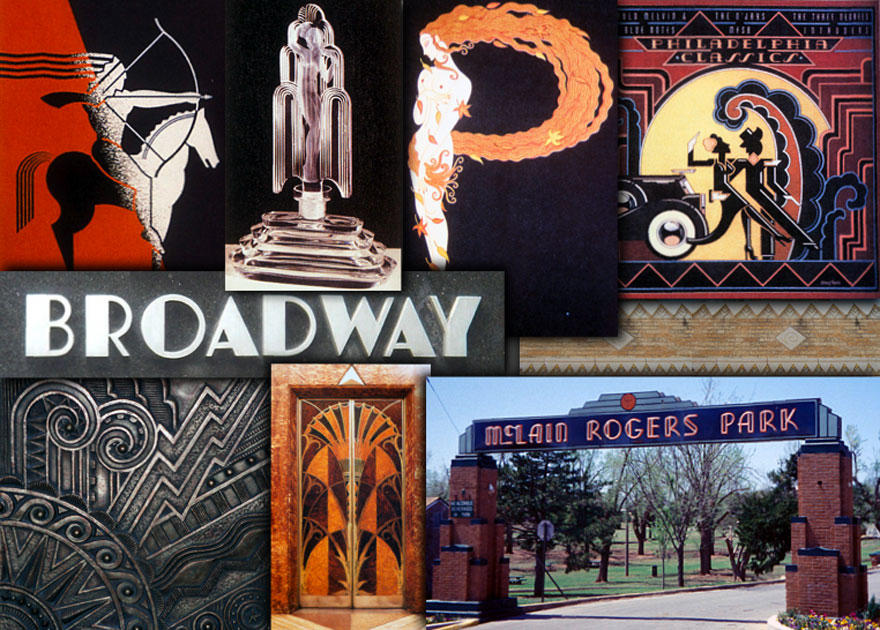
Art Nouveau

Arts & Crafts
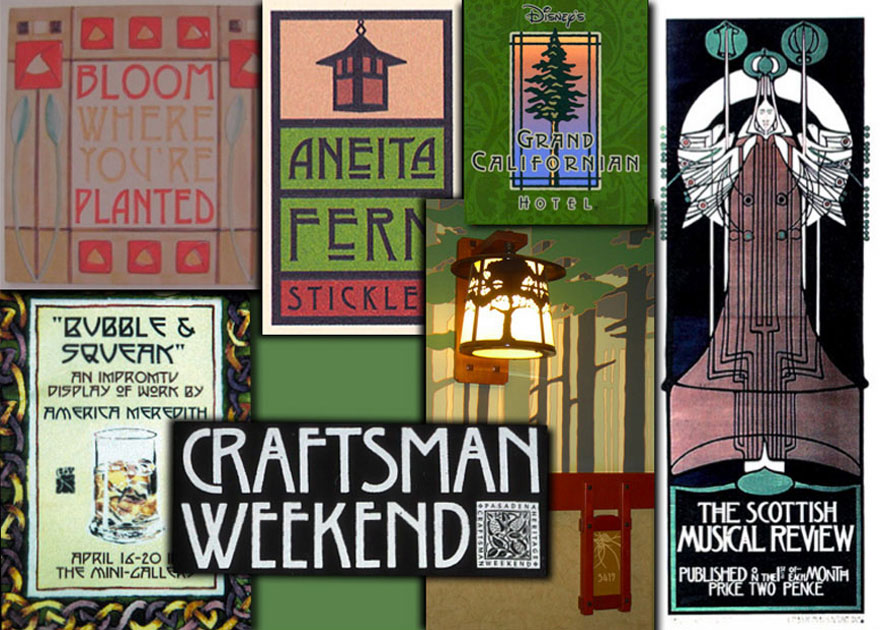
Beck map
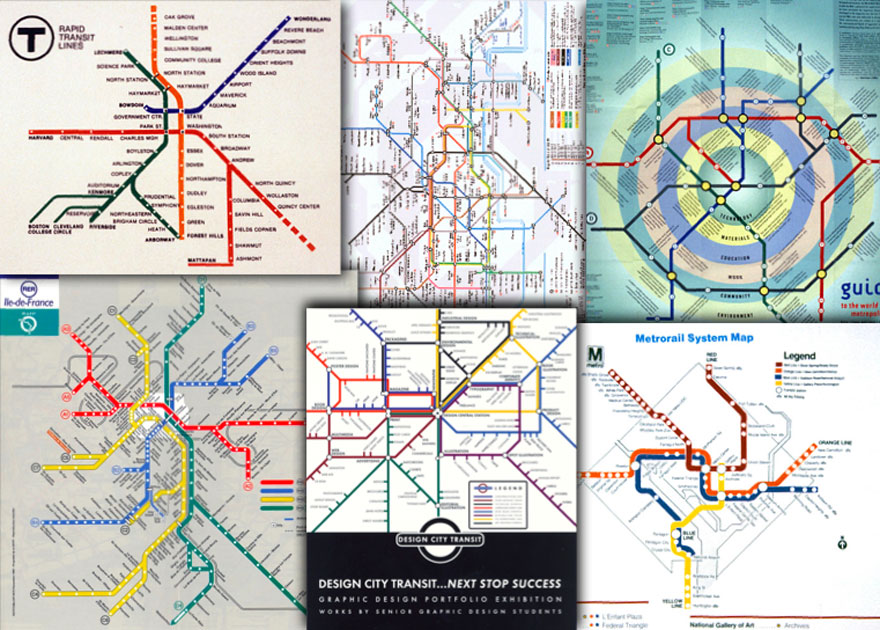
Constructivism

Cubism
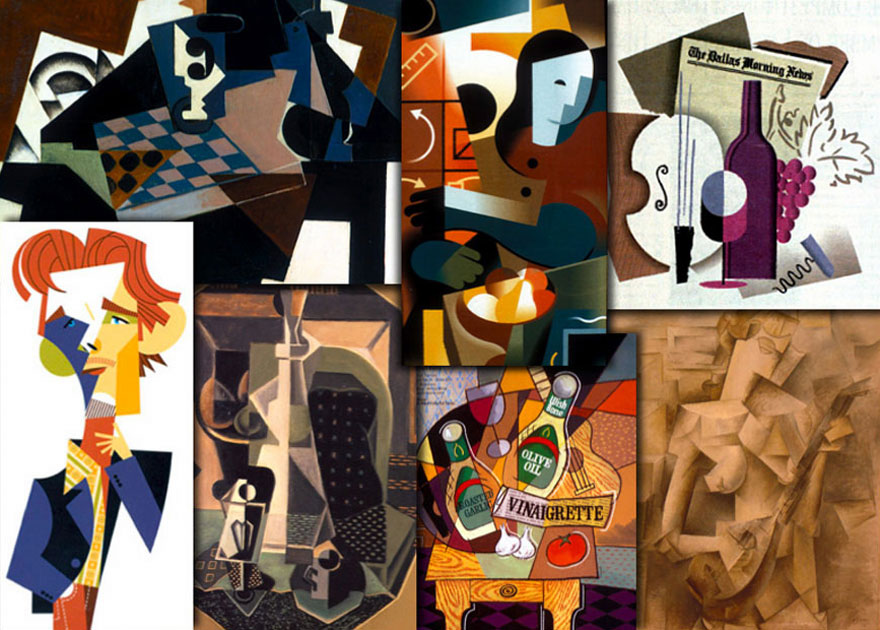
Dada

De Stijl
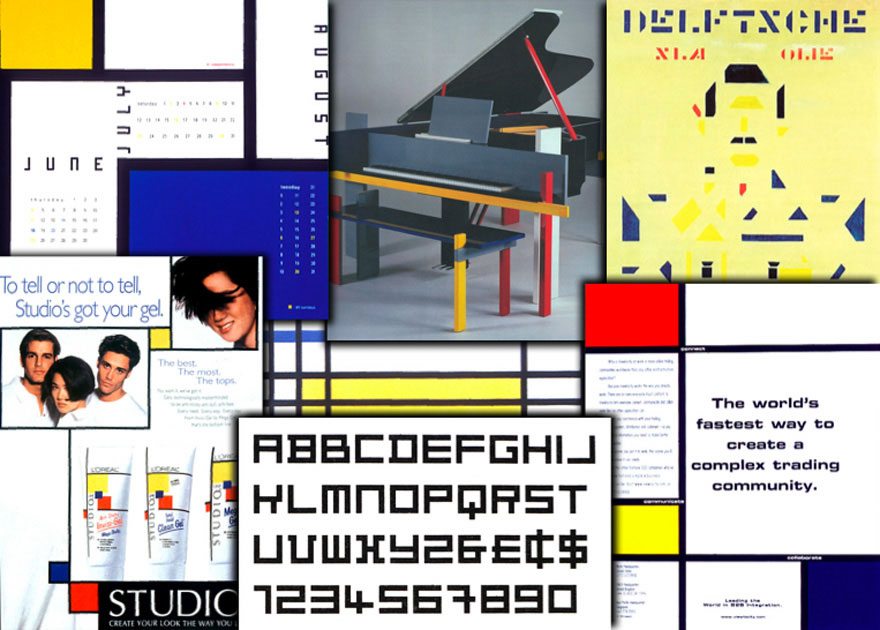
Punk
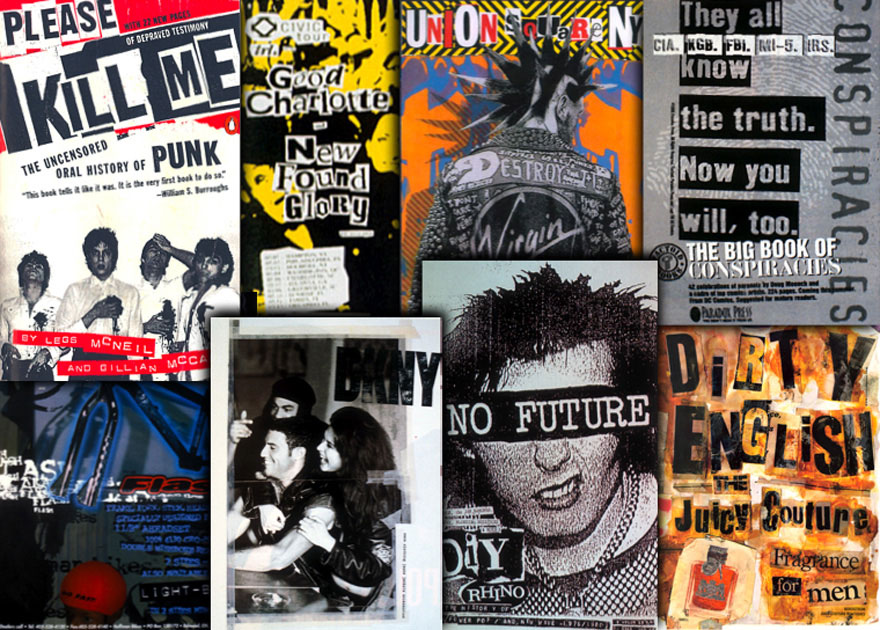
Fifties
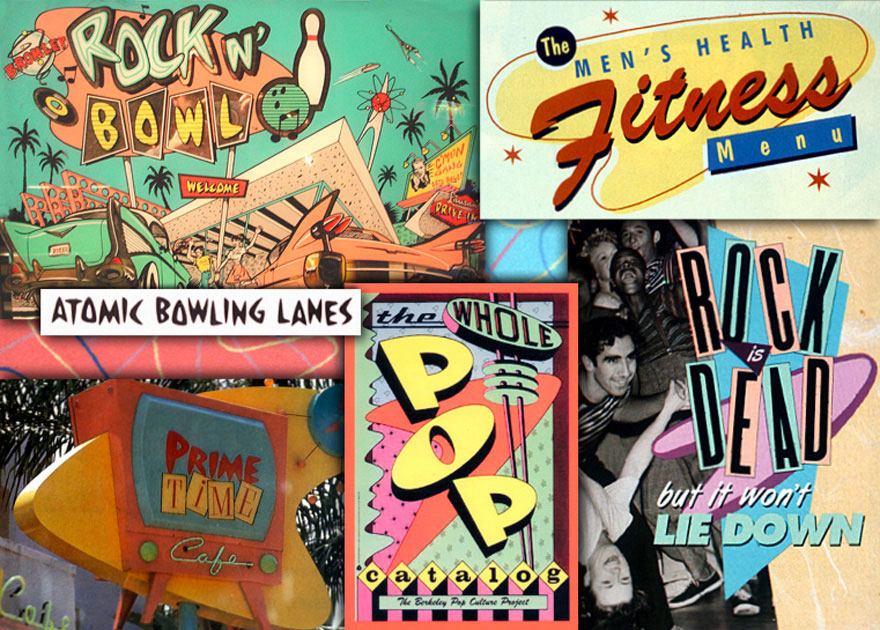
Futurism
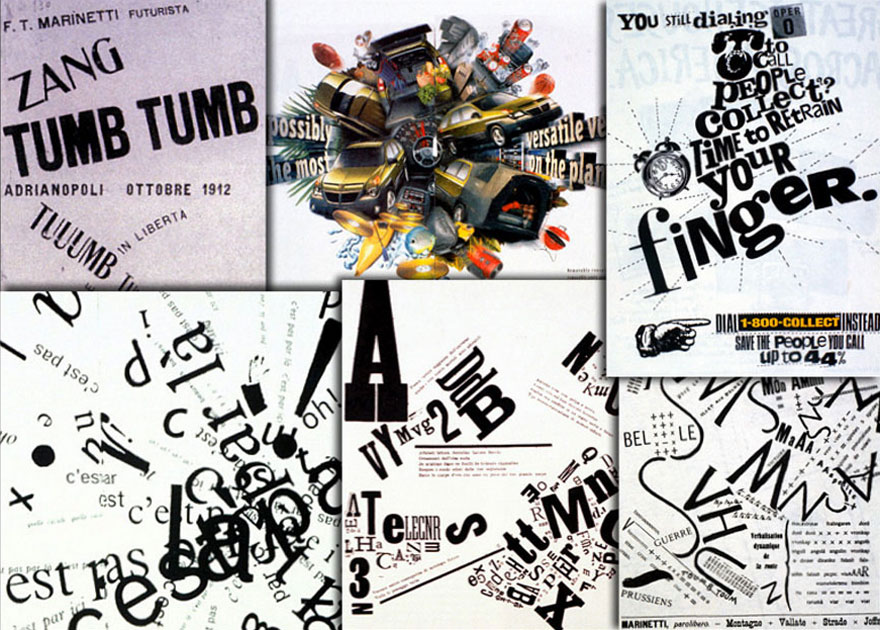
Information Graphics

International Typographic Style
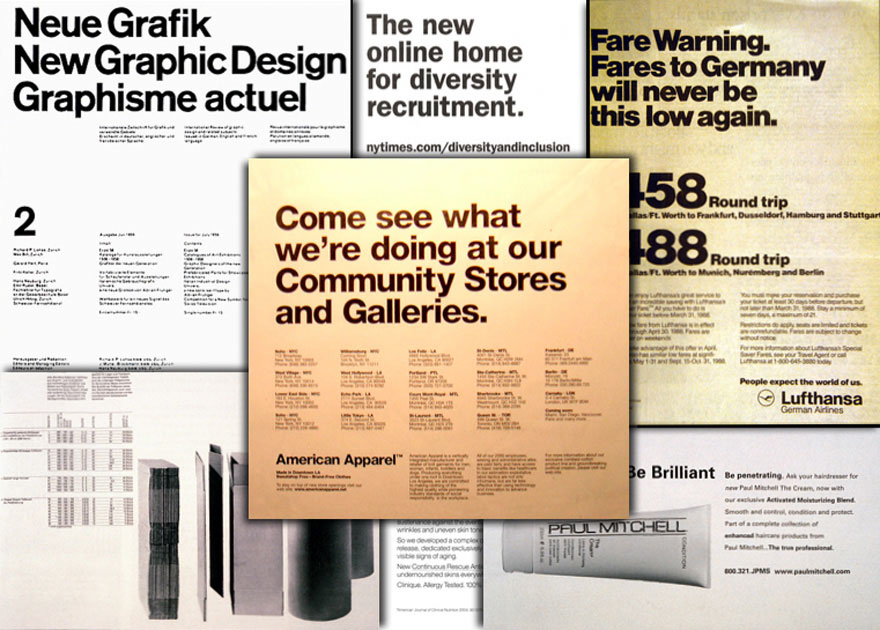
Lubalin Style

Macrap
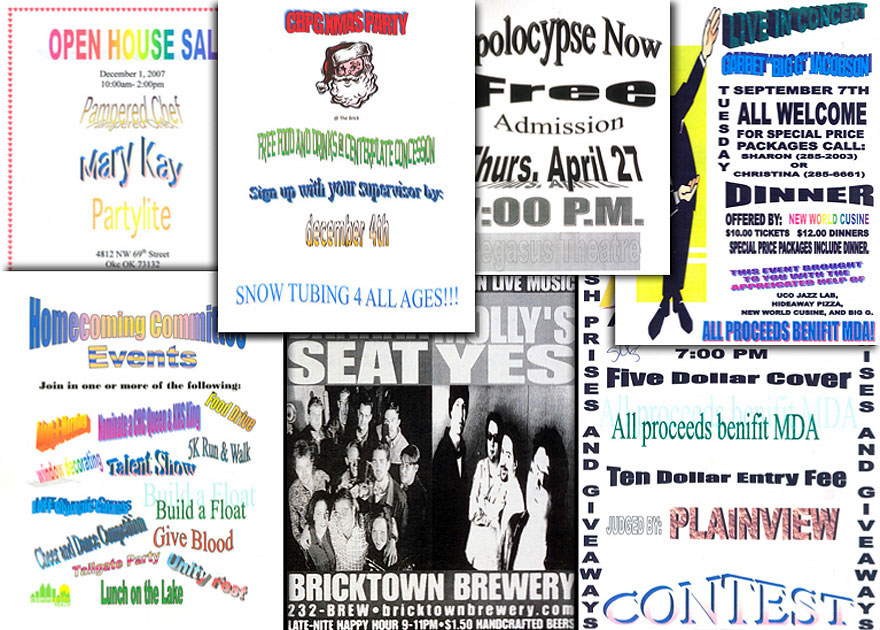
Medieval
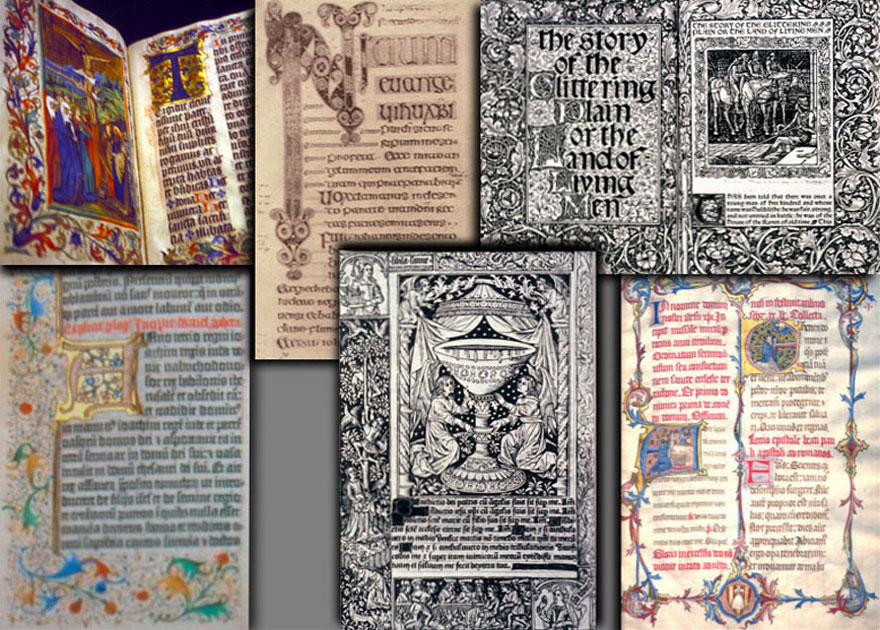
Millennium
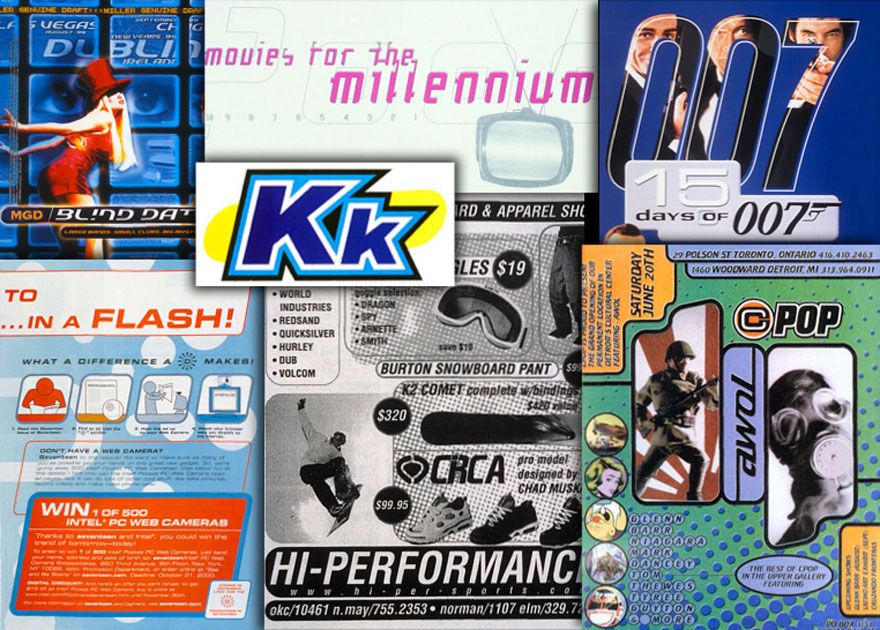
Minimalism
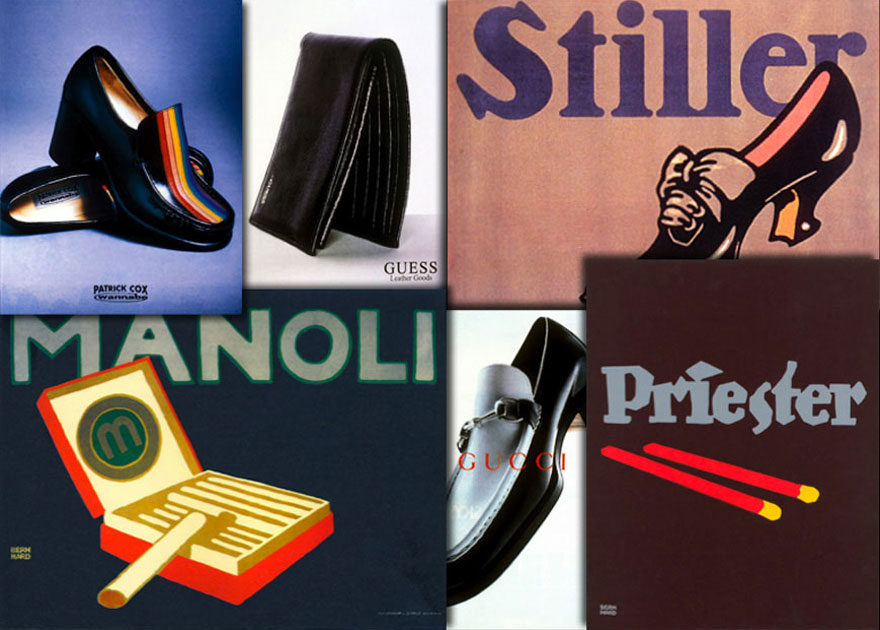
New Wave

Ornament
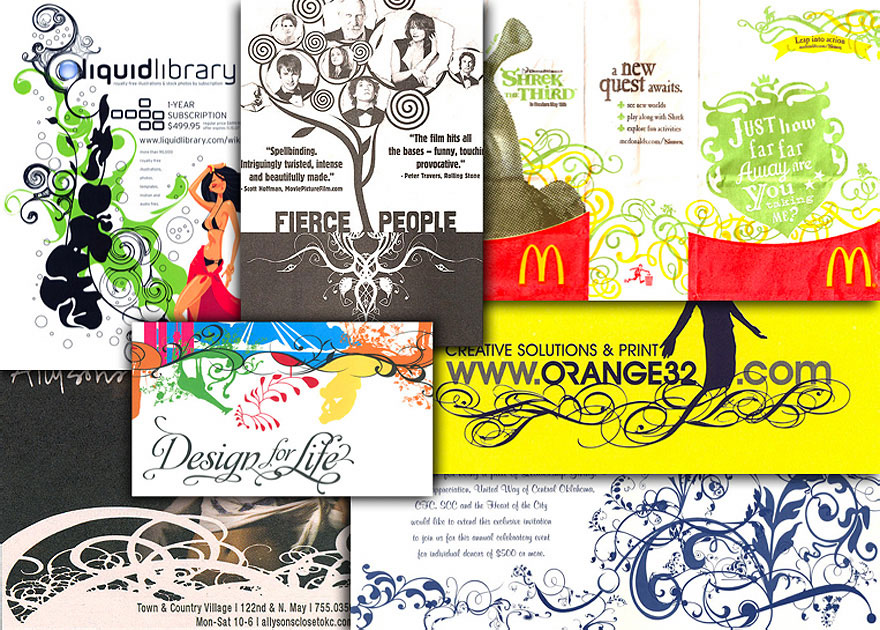
Propaganda Poster
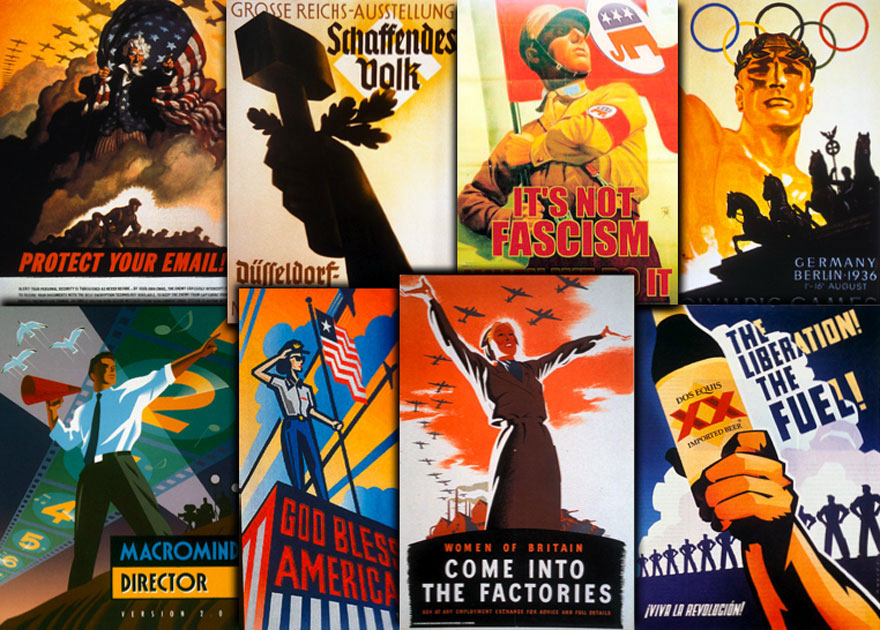
Rococo
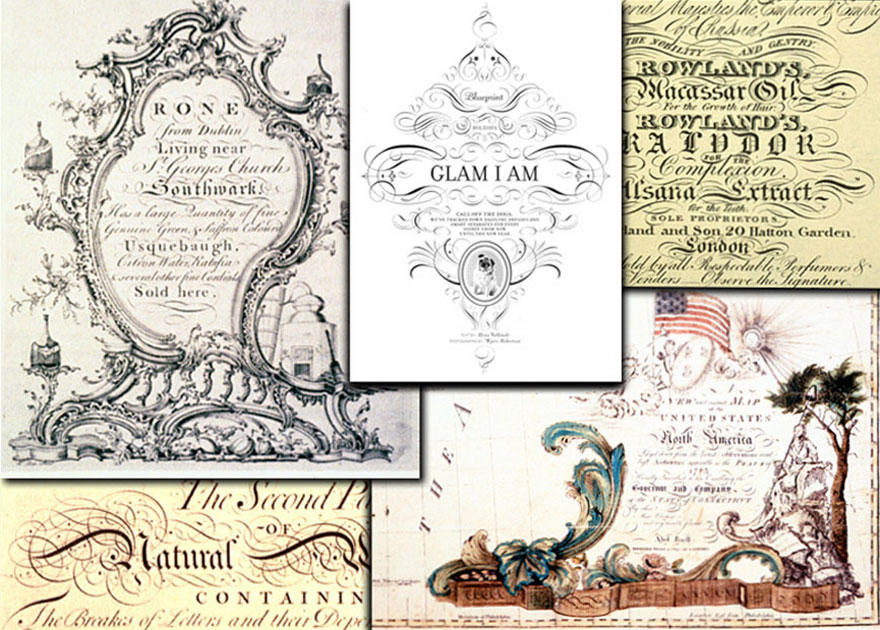
Sixties
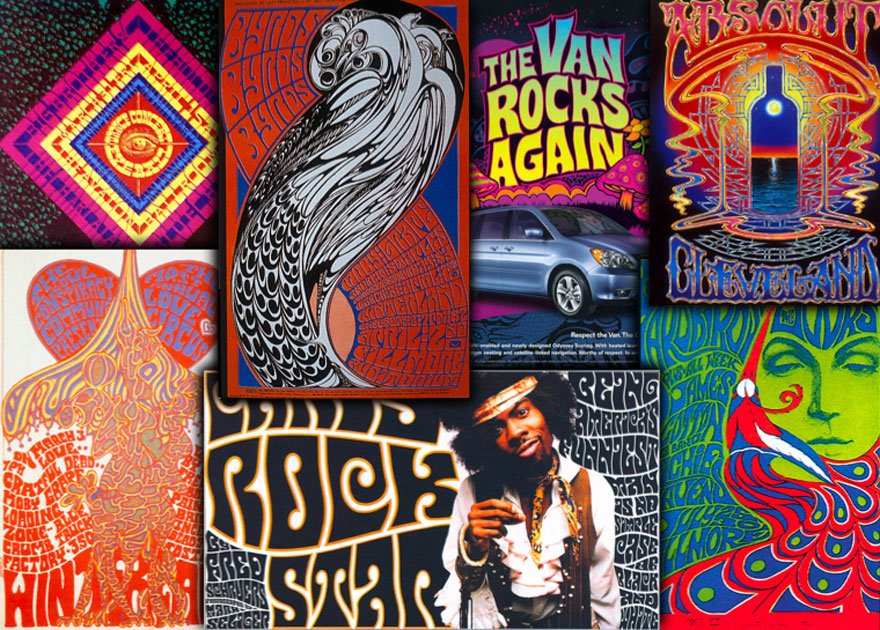
Surrealism
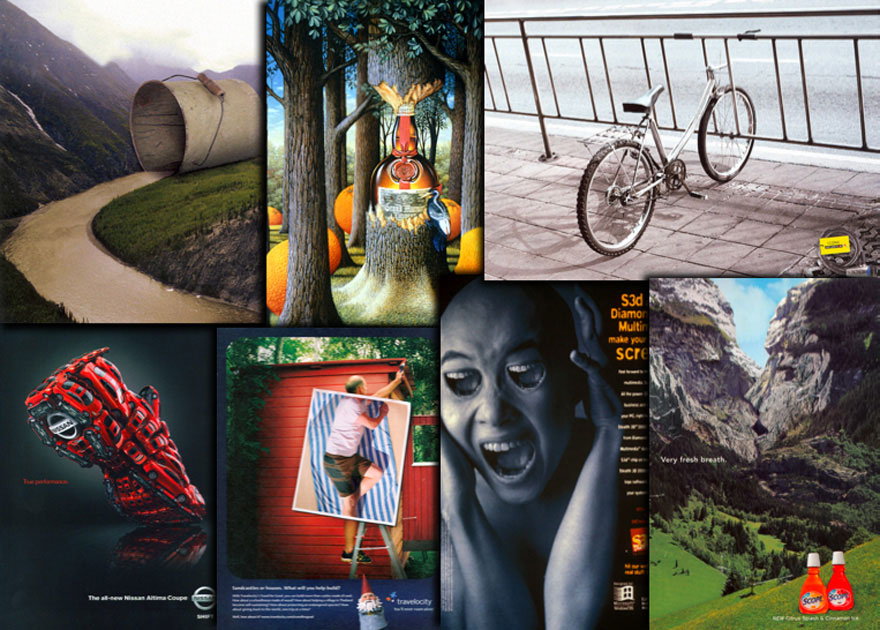
Victorian

Wood type poster

Design Film festival
• Resonant Chamber
• Starship Groove
• Marimba
www.jamesrobertwatson.com/historycourse.html